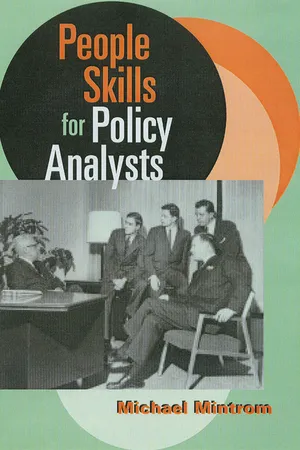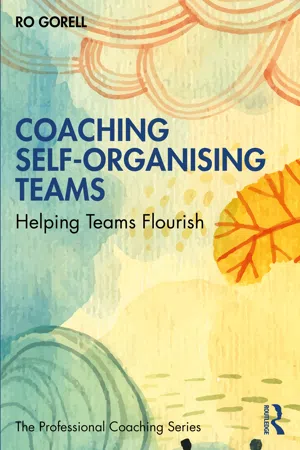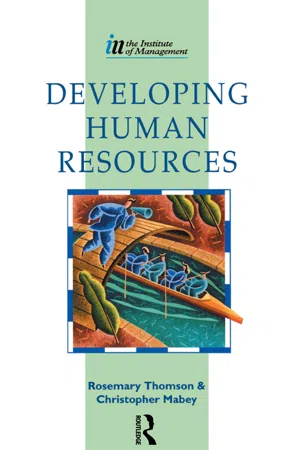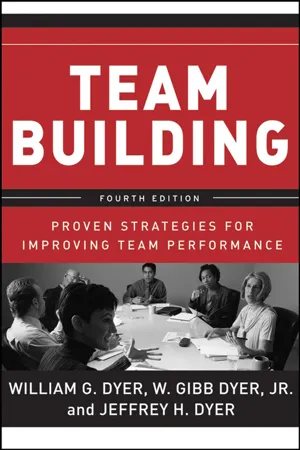Business
Working as a Team
Working as a team involves individuals collaborating and pooling their skills, knowledge, and resources to achieve common goals. It requires effective communication, mutual respect, and a shared commitment to success. By leveraging the diverse strengths of team members, businesses can enhance productivity, creativity, and problem-solving capabilities.
Written by Perlego with AI-assistance
Related key terms
12 Key excerpts on "Working as a Team"
- eBook - ePub
Safety at the Sharp End
A Guide to Non-Technical Skills
- Rhona Flin, Paul O'Connor(Authors)
- 2017(Publication Date)
- CRC Press(Publisher)
The definition of a team, according to Salas et al. (1992: p4), is:a distinguishable set of two or more people who interact, dynamically, interdependently, and adaptively toward a common and valued goal/objective/mission, who have each been assigned specific roles or functions to perform, and who have a limited life-span of membership.The team itself has performance goals, as do the individuals in it. West (2004) describes advantages for implementing team-based working in organisations as including: • enacting organisational strategy by creating consistency between changing organisational environments, strategy and structure • developing and delivering products and services quickly and cost-effectively • enabling organisations to learn and to retain learning more effectively • promoting innovation due to cross-fertilisation of ideas • integrating and linking together in ways that individuals cannot to ensure that information is processed effectively in the complex structures of modern organisations • staff who work in teams report higher levels of involvement and commitment, as well as lower stress levels than staff who do not work in teams. The main generic elements of individual team working skills are shown below.Table 5.1 Category and elements of team workingCategory Element Team working Support others. Solve conflicts. Exchange information. Co-ordinate activities. Team working is central to most work settings but is especially important in higherrisk industries, such as offshore oil and gas production, petrochemical, as well as aviation, medicine and maritime. Teams typically must function effectively from the moment they are formed to achieve their team task, therefore team members must have a common understanding of how they will be expected to work together from the outset (CAA, 2004). For instance, in the nuclear power industry, effective control-room operations rely on high-level team performance involving skills such as communication, co-ordination, co-operation and control (Stanton, 1996). - eBook - ePub
The Human Touch
Personal skills for professional success
- Philippa Thomas, Debra Paul, James Cadle(Authors)
- 2012(Publication Date)
- BCS, The Chartered Institute for IT(Publisher)
3 TEAM WORKING INTRODUCTIONPeople organise themselves into groups for many reasons, whether it is to share some work, to uncover different experiences or knowledge, or to gain a range of views on a problem. While a family may be considered a form of group, most of the organised groups we encounter are work groups. Groups can often accomplish things that individuals acting alone would find impossible. As a result, working in groups is a fundamental feature of business and has been an essential element for its development.Groups can be formal (set up and structured by management) or informal (developing naturally between individuals). However, much of the success of an organisation is not due to the development of its groups, but to how effectively they carry out their work; and a group’s effectiveness is directly related to its ability to work as a team.The act of setting up a group does not ensure that a team will result. Some groups do not ‘gel’ and may remain a collection of individuals who work together, but lack harmony and cohesion. Other groups may be more seriously dysfunctional, where active antagonism and dislike amongst the group members exists. In these cases, performance will be diminished and may be destructive rather than supportive of the organisation within which it is based.The Oxford English Dictionary (OED, 1999) provides the following definitions:- Teamwork – The combined effective actions of a group.
- Team spirit – Feelings of camaraderie among the members of a team.
Teamwork and team spirit will enhance the capability of the individual group members, thus bringing additional benefit to the organisation. Understanding how a group develops into a performing team helps us to support this transition which, in turn, will improve the organisation’s performance. Working within a high performing team is a memorable experience, one which lingers long after the team has been disbanded. - eBook - ePub
- Michael Mintrom(Author)
- 2003(Publication Date)
- Georgetown University Press(Publisher)
People often express reluctance toward working in teams. The basic problem we face is that working with others requires cooperation and coordination. Now and then, the time it takes to figure out how to work as a team seems like time that could be better spent working on individually assigned tasks. In some instances, that judgment might be correct, but most complex activities—be they in the public sector, the private sector, or the nonprofit sector—require team effort. Teamwork is essential to the successful completion of policy-related activities such as conducting analyses to resolve strategic or operational issues, coordinating organizational budgets, reforming management structures, and designing and monitoring new programs. As Rasiel (1999, 57) has observed of consulting work, “In the face of complexity, many hands don’t just make light work; they make for a better result.” Further, finding productive ways to work with others can be enormously enriching and empowering. Yet even as we recognize the merits of teamwork, it must be acknowledged that working in teams can often prove difficult.What is a team? Katzenbach and Smith (1993, 45) provide a useful definition: “A team is a small number of people with complementary skills who are committed to a common purpose, performance goals, and approach for which they hold themselves mutually accountable.” Teams produce collective work products, products that could not have been generated simply through the one-to-one assignment of tasks to individuals. As a policy analyst, you will typically move from project to project, and you might find yourself serving on several teams at once, reporting simultaneously to multiple managers and team leaders. With this in mind, you need to learn how to create conditions rapidly under which you and others can cooperate to achieve goals that none of you could achieve alone. In this chapter, I discuss the nature of teamwork and identify ways that you—as a team member or as a team leader—can raise the chances of your teams achieving success.THE LOGIC OF TEAMWORKContributors to the literature on teams have typically gained their training in disciplines such as psychology and sociology. Much of what I have to say in this chapter is based on such contributions, but a number of economists have also offered insights into teamwork through their studies of collective action and how incentives shape individual behavior. The work of economists is useful for identifying the efficiency implications of different organizational forms, including teams. Olson (1965) emphasized the importance of group size in determining how much individuals will contribute to a collectively desired outcome. His work contains important insights on the logic of teamwork. Likewise, a contribution to the economic theory of the firm offered by Alchian and Demsetz (1972) provides guidance on when to use teams and how to structure them. - eBook - ePub
Developing Skills for Business Leadership
Building Personal Effectiveness and Business Acumen
- Gillian Watson, Stefanie Reissner(Authors)
- 2023(Publication Date)
- CIPD - Kogan Page(Publisher)
Teams have been defined as having ‘an explicit shared purpose and/or task, usually in a broader organisational context’ (Thornton, 2016, cited in Widdowson and Barbour 2021). They are characterised by cooperation, collaboration, a common purpose, interdependency, the ability to solve problems and achieve goals. Wheelan (2010) posits that teams differ from groups in that they have reached a higher level of effectiveness or productiveness. The way members of the team work together is equally as important as how they work on a task. The purpose of a team’s formation may differ: some will be to complete a project or time-limited task, be a stable work team that has longevity, or perhaps be a senior management or middle management team that has its own agenda to achieve organisational success. Hence, a team depends on both individual and team contributions, and its members take collective responsibility for the results. The notion of interdependency and being a collaborative unit could also be viewed as what qualitatively separates teams from groups, as team members enter into a psychological contract with each other that group members do not (CIPD, 2011, cited in Waite et al, 2021).In organisations, teams are built to improve effectiveness and productivity and/or to fulfil the companies’ goals; they therefore depend on their individual members’ skills and capabilities that contribute to the team’s tasks and common enterprise or common purpose (Widdowson and Barbour, 2021). Therefore, the concept of ‘team’ suggests a level of interdependence, as argued by Wheelan (2010): ‘in high-performing teams people feel involved, committed and valued’. Ideally, a team comprises individuals with a wide range of skills that can help tap into each other’s strengths and achieve complex tasks in an often uncertain and pressured work environment. Hence, team members should be selected on the basis not only of the skills that they already possess but also on their willingness and ability to learn new skills as part of teamworking. Table 7.2 - eBook - ePub
Handbook for SMART School Teams, The
Revitalizing Best Practices for Collaboration
- Anne E. Conzemius, Jan O'Neill(Authors)
- 2013(Publication Date)
- Solution Tree Press(Publisher)
• We must bring our background and experiences to the table and share them. Helping our group tap into what people know and have done is an essential part of building a successful team.• We must be willing to work together to become clearer about our common purpose and goals to develop a shared sense of responsibility and commitment to achieving the group’s mission—what we aspire to achieve—and goals.These conditions are the same for everyone on a team, and we cannot forget that effective teamwork is a balancing of individual and group needs. Creating an environment where team members can contribute their individual creativity to a collaborative effort increases the success rate of the team.Tasks
Teams exist for a purpose; they must accomplish certain goals within a given time frame. That is why an essential part of effective collaboration is organizing the team’s tasks by identifying its functions and developing plans and timelines to fulfill those functions in order to achieve the desired results.Figure 1.1: Three cornerstones of effective collaboration.Chapter 3 provides guidance on how a team can identify and organize its tasks. The basic principles are the following.• Be clear about the purpose and goals of the work.• Identify tasks that move the team toward those goals.• Clarify roles and responsibilities around those tasks.• Develop skills to work together effectively.Processes
Try to recall a major decision a team to which you belonged faced. How did the team make that decision? Did your group talk about how it would make the decision before making it? If the answer is no, you are not alone. Even when a committed group of skilled and highly motivated people comes together around a clear and common purpose, conflicts often emerge when the group has not discussed how to work together. In too many cases, team processes such as decision making, problem solving, communicating, and having meetings are informal or undefined. - eBook - ePub
Street Law
Theory and Practice
- Frances Ridout, Linden Thomas(Authors)
- 2023(Publication Date)
- Hart Publishing(Publisher)
Write a definition for the word ‘team’ below. It may help to think about a time you have been part of a team. What were the characteristics that made it a ‘team’, as opposed to merely a collection of individuals?A team is …We define a team as a group of people working together towards a common goal. Katzenbach and Smith add more detail to this definition: ‘… a small number of people with complementary skills, who are committed to a common purpose, set of performance goals, and approach for which they hold themselves mutually accountable’.5Activity:Think of a time when you have worked as part of a team. You can take an example from your experience working on a Street Law project, or from elsewhere.Now, consider Katzenbach and Smith’s definition of a team, as set out above. We have broken down the different elements of the description and placed them into the lefthand column of the table below. Can you relate your chosen teamwork experience to each element of their definition? Write your thoughts in the righthand column. - eBook - ePub
The Definitive Executive Assistant & Managerial Handbook
Leadership for PAs, Executive Assistants, Senior Administrators and Office Managers
- Sue France(Author)
- 2021(Publication Date)
- Kogan Page(Publisher)
04Leading effective office based and virtual teams to success
This chapter will define what a ‘team’ is and what a leader’s role is within a team. It will explain team dynamics and the five stages of team development, including the importance of creating a Team Charter using the example of ‘Developing an internal assistant network’. With the kind permission of Belbin® Associates, Belbin® team roles are explained so you can read the descriptions and determine what your preferred behavioural style is, together with each style’s strengths. This will enable you to form well-balanced and productive teams. It also describes what each team role’s allowable weakness and non-allowable weakness are so that you can be aware of how you can reduce your weaknesses where possible. I have also laid out ground rules for effective teamwork that can be included in the Team Charter.This chapter also addresses best practice for virtual and remote working and how to effectively stay connected with your team.Definition of a team
A team is two or more people working together inter-dependently, who have the same purpose and goals and work towards achieving a shared objective. They have the complementary skills necessary to carry out that purpose successfully together.We all work in teams, whether we are working with one boss or more and alongside our colleagues and whether in the same office or virtually. You may lead a team, a committee or task force, organize an event with a team, lead a project management team or be part of one, or coordinate a group of people to achieve a common goal. This chapter is about giving you the tools and techniques to be a powerful team member and lead effective teams, including your boss(es), for a successful outcome.Assistants are the fount of all knowledge, the technical expert, the strategic counsel, the problem solver, the resource investigator, all of which is helped by having networks both internal and external to the organization. Your networks are invaluable to your success, to prevent reinventing the wheel and to share knowledge and have outstanding support for each other. You may lead an assistant networking team within your company, and if you haven’t got one yet then I suggest you think about organizing one and becoming its team leader. Assistant networks are an invaluable source of support, resources, training, self development and keeping connected as they can be conducted online, in person or a hyrbid. There is a section below on how to develop an internal assistant network. - eBook - ePub
Effective Teamwork
Practical Lessons from Organizational Research
- Michael A. West(Author)
- 2012(Publication Date)
- Wiley-Blackwell(Publisher)
Being a team player means having a clear focus on Working as a Team member to enable the team to achieve its objectives and working towards that. Being a team player means being positive and supportive to all other team members and creating an atmosphere of confidence, enjoyment and engagement in the team. Being a team player means continually working to ensure good relationships in the team and between the team and the rest of the organization. In essence, being a team player means participating fully in the team.We create teams in order to utilize the skills, knowledge and abilities of people who make up the team in ways that ensure their collective efforts enable them to accomplish tasks they could not manage alone. Participation involves encouraging team members to meet together, share information and ideas, and debate fully and intelligently the best way of accomplishing the task of providing products or services for customers and clients. Team participation involves team members taking individual and collective responsibility for team objectives, team strategies and team processes. While team work implies differentiation of roles and responsibilities and thereby that people will take leadership positions, this does not mean that the team leader is solely responsible for determining team objectives, strategies, processes and outcomes. On the contrary, in effective work teams, all team members are aware of and sensitive to team functioning and therefore take responsibility for ensuring success.Team participation includes four key elements: interacting, information sharing, influencing and ensuring safety.InteractionIn order for a group of individuals who share a common goal to be called a team they must have some ongoing interaction, otherwise their efforts are essentially uncoordinated and disaggregated. Teams interact during task performance and socially; both are equally important. Social interactions might include parties, lunches or informal chats in the corridors to discuss family matters or sporting events. These interactions strengthen the attachment, cohesion and familiarity which enable people to feel safe with one another. Interaction during task performance provides an exchange of information, communication, etc., which enables the team to coordinate individual member efforts to achieve their shared goals. Interaction also contributes to the development of shared mental models about the nature of the task and how it should be performed. In effect they learn to dance the dance of teamwork better, the more time they spend dancing together. Imagine the success of a football team that only met to play together once or twice a year, compared with a team that played together and discussed their performance every week. - eBook - ePub
Coaching Self-Organising Teams
Helping Teams Flourish
- Ro Gorell(Author)
- 2021(Publication Date)
- Routledge(Publisher)
The reality of remote working forced autonomous working and confronted many organisations that operated a more traditional hierarchical model. In a remote online world, managers could no longer ‘check up’ on employees to see if they were doing what they should. Trust, therefore, became valuable currency conjoined with autonomy.In this context, the pace of change has led, if not driven, organisations to seek better ways of working and leveraging their resources, including people. Teams and teamwork are a way of creating choice and cognitive diversity – if done well! The subject of this book is how to blend these, so the whole is greater than merely the sum of the parts.1.1 What is a team?
In researching this book, it became apparent that these four words have generated hundreds of books, research, discussion, arguments and counterarguments. Such is the enthusiasm for the quest. The follow-on question, ‘why does this matter?’, is perhaps more important for the coach working with a ‘team’.First, let us explore what constitutes a team. How will the organisation know if it has created a ‘real team’ or a group? The simplest explanation of what constitutes a teal team comes from the research of Michael West and colleagues working with the U.K. National Health Service, particularly in health and social care. He outlines three prerequisites for a real team:- Clear, shared objectives
- Working closely together
- Meets regularly to review and improve performance
If there is little interdependence and collective accountability, and no shared purpose, the organisation likely creates a group of people rather than a team. Again, a simple definition of a group is a collection of people who report to the same function or manager. In organisational terms, this is usually the reporting line on an organisation chart. The link between the individuals is merely the fact that they report through the same structure with individual accountabilities and contributions. The exception to this might be at the senior executive level. Typically, executive team members have discrete responsibility for a business unit and collective responsibility to deliver business-wide results. Delivering business-wide results does not necessarily mean that the executive team will be a real team – given the explanation earlier about complexity, it is increasingly likely that more executive teams will now have to function as real teams (Wage-man et al. 2008). - eBook - ePub
- Christopher Mabey, Rosemary Thomson(Authors)
- 2012(Publication Date)
- Routledge(Publisher)
On the negative side, teams may produce more conventional rather than more innovative responses to problems. The reason for this is that team decisions may regress towards the average, with group communications cancelling out the more innovative decision options. It depends on how innovative the team is in terms of its membership, its norms and its values. A team that is anchored to creative values, and prides itself on its originality, may work to an innovative behavioural average.Teamwork may be also inappropriate when you want a fast decision made. For instance, team decision making is usually slower than individual decision making because of the need for communication and consensus about the decision taken. Despite the business successes of the Japanese companies, it is now recognized that promoting a collective organizational identity and responsibility for decisions may significantly slow operations down.Box 8.1 Teamwork can be hard workIn this section, we see that there are many factors, internal and external, that will influence the choice of working in groups or teams. These are summarized below:Most functional executives, brought up in the turbulence of politics and interactional warfare, find the transition from functional to strategic mode very difficult to make; they do not always see the difference – and if they do, they are reluctant to leave their mountain top, the summit of knowledge, experience and hence power, for the equality and shared uncertainty of strategic decision-making. And yet this is one area where real teamwork is not only necessary but vital …Strategic planners are often guilty of pushing management groups towards handling uncertainty without the concomitant abilities to share and work with feelings. Team-builders are often guilty of the converse sin – pushing management groups to be open and share their feelings when the group has no intention whatever of getting into work where the level of uncertainty is high. Neither will succeed. It is no coincidence that both strategic planning and team-building can fall quickly into disrepute; it may be too late to save strategic planning from the management scrapheap – it is not too late to save team-building. (Critchley and Casey, 1986, pp.427, 436). - eBook - ePub
Work, Organizational, and Business Psychology
An Introductory Textbook
- Hannes Zacher, Nale Lehmann-Willenbrock(Authors)
- 2022(Publication Date)
- Kohlhammer Verlag(Publisher)
team , members work together on one or several tasks that contribute to the goals of an organization. A team is defined as: »(a) two or more individuals who (b) socially interact (face-to-face or, increasingly, virtually); (c) possess one or more common goals; (d) are brought together to perform organizationally relevant tasks; (e) exhibit interdependencies with respect to workflow, goals, and outcomes; (f) have different roles and responsibilities; and (g) are together embedded in an encompassing organizational system, with boundaries and linkages to the broader system context and task environment« (Kozlowski & Ilgen, 2006, p. 79).Finally, the term teamwork is defined as »the integration of individuals’ efforts toward the accomplishment of a shared goal« (Mathieu et al., 2017; p. 458). Therefore, teamwork is a process that leads to team effectiveness. This process includes team members’ experiences (e.g., feelings, thoughts, and attitudes) and behaviors while they interact with one another in trying to achieve a common goal.A Brief History of Teamwork in Organizations
Research on teams has increased rapidly since the 1980s. Given the relevance of teams for accomplishing most of the work in today’s organizations, this trend will likely continue. The spread of teamwork in practice has not been linear, but has rather been »jumpstarted« by specific events and historical developments (for a detailed analysis, see Weiss & Hoegl, 2015). The relevance of teamwork increased during both World War I and II, perhaps because social cohesion and collective identity were important both for boosting military team efforts as well as civilian morale. Famous success stories such as the development of penicillin further increased the popularity of teamwork. In the 1940s to 50s, organizations began to establish teamwork in response to the human relations movement ( Chap. 1 ), moving away from Tayloristic principles and toward teamwork as an organizing form. In the 1960s and 70s, the societal spread of teamwork decreased, likely due to the transformation of social values and the focus on individualism (Weiss & Hoegl, 2015).Teamwork began to really take off in the 1980s, triggered by management innovations such as team-based production at Volvo in Sweden or the Toyota Production System, which inspired reorganization across many industries and placed a strong emphasis on teamwork for accomplishing continuous improvement. The implementation of self-managed teams, such as project teams, production teams, and quality circles spread rapidly beginning in the late 1980s and throughout the 90s. These developments paved the way for new management approaches such as lean management and Six Sigma, which focus on flattening organizational hierarchies and establishing teams as self-organized forms of work that take on additional responsibilities and promote organizational performance (e.g., Gutiérrez et al., 2012). In the academic setting, research and educational activities also embraced teamwork widely in the 1990s. Taken together, these developments have established the quality of being a »team player« as a desirable attribute that is frequently mentioned in job advertisements. Today, organizations critically rely on teams for mastering current and future challenges, and the study of team processes and team effectiveness has become a core topic in organizational psychology research. - eBook - ePub
Team Building
Proven Strategies for Improving Team Performance
- William G. Dyer, W. Gibb Dyer, Jeffrey H. Dyer(Authors)
- 2010(Publication Date)
- Jossey-Bass(Publisher)
Provide clear top management support for team development. In any organization people at lower levels respond to cues from upper management about what is truly important in the organization. A key role for leaders is to create a vision for others of what is possible for the organization to achieve. A company with a clear, team-related mission statement will assign a top corporate officer or group to continually develop and monitor team action. This sends a clear signal that teams are fundamentally important and that to succeed everyone must learn to contribute to the team effort. Too many organizations give some emphasis to team building in a middle-management seminar or training program, but there is little evidence that upper management takes any of this seriously. Bain & Company is a good example of an organization that clearly states in its mission and goals the need for teamwork.Figure 3.2. Team Context and Composition Scale.Scoring: Each person should add up his or her score and divide by 13. A score of 3.75 or higher would indicate that the organization’s context and team composition generally support team performance. Scores between 2.5 and 3.75 indicate that there is moderate support for team performance. Scores between 1.0 and 2.5 indicate that there are some serious problems related to context and composition that are hindering team performance. Also, if responses to even one or two items are very low (1 or 2) this suggests that action may need to be taken soon to improve the context or team composition. However, if the response to item 1 (the need for teamwork) is low (either a 1 or 2), which typically means that the interdependence of team members is largely modular or sequential, then the mean score may not need to be as high as in a team in which teamwork is essential to achieve its goals (in other words, when there is a need for reciprocal interdependence).2. Create organizational rewards to support teamwork.
Index pages curate the most relevant extracts from our library of academic textbooks. They’ve been created using an in-house natural language model (NLM), each adding context and meaning to key research topics.











